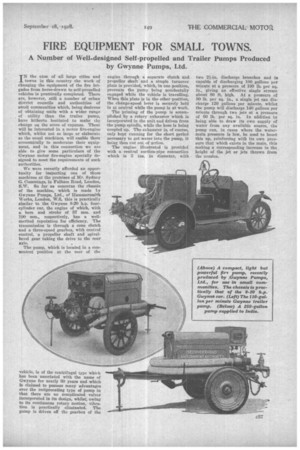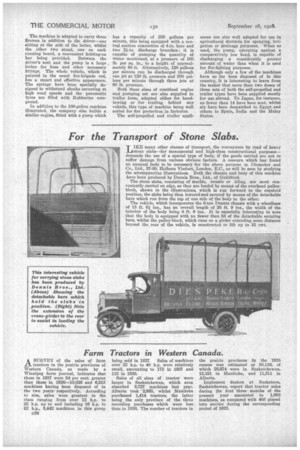FIRE EQUIPMENT FOR SMALL TOWNS,
Page 21

Page 22

If you've noticed an error in this article please click here to report it so we can fix it.
A Number of Well-designed Self-propelled and Trailer Pumps Produced by Gwynne Pumps, Ltd.
TN the case of all large cities and towns in this country the work of changing the equipment of the fire brigades from horse-drawn to self-propelled vehicles is practically completed. There are, however, still a number of urban district councils and authorities of small communities which, being desirous of obtaining units with a wider range of utility than the trailer pump, have hitherto hesitated to make the change on the score of expense. These will be interested in a motor fire-engine which, whilst not so large or elaborate as the usual machines, will enable them economically to modernize their equipment, and in this connection we are able to give some particulars of the Gwynne motor fire-engine specially designed to meet the requirements of such authorities.
We were recently afforded an opportunity for inspecting one of these machines at the premises of Mr. Sydney G. Cummings, in Fulham Road, London, S.W. So far as concerns the chassis of the machine, which is made ty Gwynne Pumps, Ltd., of Hammersmith. Works, London, W.6, this is practically similar to the Gwynne 8-20 h.p. fourcylinder car, the engine of which, with a bore and stroke of 57 mm. and 300 mm., respectively, has a wellmerited reputation for efficiency. The transmission is through a cone clutch and a three-speed gearbox, with central control, a propeller shaft and spiralbevel gear taking the drive to the rear axle.
The pump, which is located in a convenient position at the rear of the -vehicle, is of the centrifugal type which has been associated with the name of Gwynne for nearly 80 years and which is claimed to possess many advantages over the reciprocating type of pump in that there are no complicated valve4 incorporated in its design, whilst, owing to its continuous rotary motion, vibration is practically eliminated. The pump is driven off the gearbox of the engine through a separate clutch and propeller shaft and a simple turnover plate is provided, which, in one .position, prevents the pump being accidentally engaged while the vehicle is travelling. When this plate is in the other position, the change-speed lever is securely held in at neutral while the pump is at work.
The priming of the pump is accomplished by a rotary exhauster which is incorporated in the unit and driven from the pump spindle, while the hose is being coupled up. The exhauster is, of course, only kept running for the short period necessary to get water into the pump, it being then cut out of action.
The engine illustrated is provided with a central suction-pipe connection which is 3 ins. in diameter, with two 21-in. discharge branches and is capable of discharging 100 gallons per minute at a pressure of 100 lb. per sq. in., giving an effective single stream about 80 ft. high. At a pressure of 80 lb. per sq. in., a single jet can discharge 120 gallons per minute, whilst the pump will discharge 140 gallons per minute through two jets at a pressure of 60 lb. per sq. in. In addition to being able to draw its own supply of water from any available source, the pump can, in cases where the watermain pressure is low, be used to boost this up, reinforcing with its own pressure that which exists in the main, this making a corresponding increase in the height of the jet or jets thrown from the nozzles. The machine is adapted to carry three firemen in addition to the driver—one sitting at the aide of the latter, whilst the other two stand, one on each 'tinning board, a convenient holding-on bar being provided. Between the driver's seat and the pump is a large locker for hose and other necessary fittings. The whole vehicle, which is painted in the usual fire-brigade red, has a smart and effective appearance. The springs have been specially designed to withstand shocks occurring at high road speeds and the pneumatic fyres are filled with Rubberine compound.
In addition to the 100-gallon machine illustrated, the company also builds a similar engine, fitted with a pump which has a capacity of 250 gallons per minute, this being equipped with a central suction connection of 4-in, bore and two 2i-in. discharge branches ; it is capable of pumping the quantity of water mentioned, at a pressure of 100 lb. per sq. in., to a height of approximately 80 ft. Alternatively, 120 gallons per minute can be discharged through one jet at 120 lb. pressure and 300 gallons per minute through three jets at 60 lb. pressure.
Both these sizes of combined engine and pumping set are also supplied in trailer form, adapted either for handtowing or for trailing behind any vehicle, this type of machine being well suited for fire protection in factories.
The self-propelled and trailer appli ances are also well adapted for use in agricultural districts for spraying, irrigation or drainage purposes. When so used, the pump, operating against a comparatively low head, is capable of discharging a considerably greater amount of water than when it is used for fire-fighting purposes.
Although only a few of the machines have so far been disposed of in this country, it is interesting to learn from the maker that more than two dozen of these sets of both the self-propelled and trailer types have been supplied mostly for use abroad. To Japan, for instance, no fewer than 14 have been gent, whilst six have been despatched to Egypt and others to Spain, India and the Malay States.
































